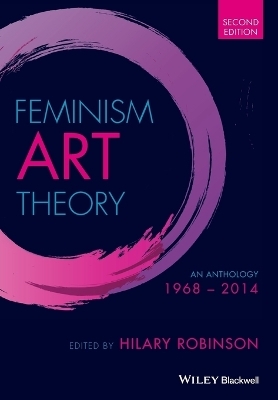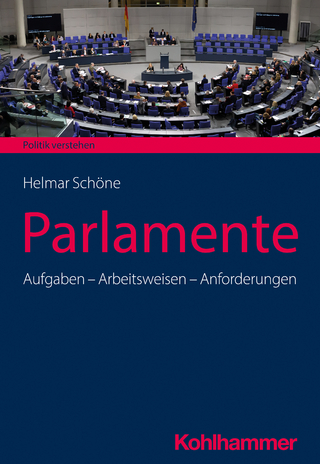
Feminism Art Theory
Wiley-Blackwell (Verlag)
978-1-118-36059-0 (ISBN)
Completely revised, retaining only one-third of the texts of the earlier edition, with all other material being new inclusions
Brings together 88 revealing texts from North America, Europe and Australasia, juxtaposing writings from artists and activists with those of academics
Embraces a broad range of threads and perspectives, from diverse national and global approaches, lesbian and queer theory, and postmodernism, to education and aesthetics
Includes many classic texts, but is particularly notable for its inclusion of rare and significant material not reprinted elsewhere
Provides a uniquely flexible resource for study and research due to its scale and structure; each of the seven sections focuses on a specific area of debate, with texts arranged chronologically in order to show how issues and arguments developed over time
Hilary Robinson is Dean of the School of Art and Design and Professor of Visual Culture at Middlesex University London, having previously held positions at Carnegie Mellon University, USA, and the University of Ulster, Northern Ireland. She is the author of Reading Art, Reading Irigaray: The Politics of Art by Women (2006), and the editor of Visibly Female: Women and Art Today (1987).
Preface x
Acknowledgements and Sources xii
Introduction: Feminism–Art–Theory: Towards a (Political) Historiography 1
1 Overviews 8
Introduction 8
1.1 Gender in/of Culture 12
• Valerie Solanas, ‘Scum Manifesto’ (1968) 12
• Shulamith Firestone, ‘(Male) Culture’ (1970) 13
• Sherry B. Ortner, ‘Is Female to Male as Nature is to Culture?’ (1972) 17
• Carolee Schneemann, ‘From Tape no. 2 for Kitch’s Last Meal’(1973) 26
1.2 Curating Feminisms 28
• Cornelia Butler, ‘Art and Feminism: An Ideology of Shifting Criteria’ (2007) 28
• Xabier Arakistain, ‘Kiss Kiss Bang Bang: 86 Steps in 45 Years of Art and Feminism’ (2007) 33
• Mirjam Westen, ‘rebelle: Introduction’ (2009) 35
2 Activism and Institutions 44
Introduction 44
2.1 Challenging Patriarchal Structures 51
• Women’s Ad Hoc Committee/Women Artists in Revolution/WSABAL, ‘To the Viewing Public for the 1970 Whitney Annual Exhibition’ (1970) 51
• Monica Sjöö, ‘Art is a Revolutionary Act’ (1980) 52
• Guerrilla Girls, ‘The Advantages of Being a Woman Artist’ (1988) 54
• Mary Beth Edelson, ‘Male Grazing: An Open Letter to Thomas McEvilley’ (1989) 54
• Lubaina Himid, ‘In the Woodpile: Black Women Artists and the Modern Woman’ (1990) 60
• Jerry Saltz, ‘Where the Girls Aren’t’ (2006) 62
• East London Fawcett, ‘The Great East London Art Audit’ (2013) 64
2.2 Towards Feminist Structures 66
• WEB (West–East Coast Bag), ‘Consciousness‐Raising Rules’ (1972) 66
• Women’s Workshop, ‘A Brief History of the Women’s Workshop of the Artist’s Union 1972–1973’ (c. 1973) 67
• Martha Rosler, ‘Well, is the Personal Political?’ (1980) 68
• Lucy Lippard, ‘Trojan Horses: Activist Art and Power’ (1984) 69
• Anne Marsh, ‘A Theoretical and Political Context’ (1985) 79
• Xabier Arakistain et al., ARCO Manifesto: ‘Politics of Equality between Men and Women in the Art World’ (2005) 85
• Parliament of Spain, ‘Article 26: Equality in Artistic and Intellectual Creation and Production’ (2007) 86
2.3 Activism in Practice 88
• Mierle Laderman Ukeles, ‘Manifesto for Maintenance Art, 1969!’ (1969) 88
• Leslie Labowitz‐Starus and Suzanne Lacy, ‘In Mourning and in Rage …’ (1978) 91
• Zoe Leonard, ‘I Want a President’ (1992) 95
• Andrea Fraser, ‘There’s No Place like Home’ (2012) 96
• Nadezhda Tolokonnikova, ‘Opening Courtroom Statement by Nadya’ (2013) 102
2.4 Education 106
• Miriam Schapiro, ‘The Education of Women as Artists: Project Womanhouse’ (1972) 106
• Lisa Tickner, ‘Retrospect’ (2008) 107
• Griselda Pollock, ‘Opened, Closed and Opening: Reflections on Feminist Pedagogy in a UK University’ (2010) 114
• Lisa Nyberg and Johanna Gustavsson, ‘Radical Pedagogy’ (2011) 124
3 Historical and Critical Practices 129
Introduction 129
3.1 Interrogating ‘Art History’ 134
• Linda Nochlin, ‘Why Have There Been No Great Women Artists?’ (1971) 134
• Griselda Pollock, ‘Women, Art and Ideology: Questions for Feminist Art Historians’ (1983) 149
• Mira Schor, ‘Patrilineage’ (1991) 159
3.2 Feminist/Writing 165
• Carol Duncan, ‘Virility and Domination in Early Twentieth Century Vanguard Painting’ (1973) 165
• Joan Borsa, ‘Frida Kahlo: Marginalization and the Critical Female Subject’ (1990) 169
• Freida High W. Tesfagiorgis, ‘In Search of a Discourse and Critique/s that Center the Art of Black Women Artists’ (1993) 185
• Maureen Connor, ‘Working Notes: Conversation with Katy Deepwell’ (2002) 198
• Martina Pachmanová, ‘In? Out? In Between? Some Notes on the Invisibility of a Nascent Eastern European Feminist and Gender Discourse in Contemporary Art Theory’ (2009) 203
4 Materials, Practices, Choices 217
Introduction 217
4.1 Aesthetic Choice 223
• Judy Chicago, ‘Woman as Artist’ (1971) 223
• Marjorie Kramer, ‘Some Thoughts on Feminist Art’ (1971) 225
• Pat Mainardi, ‘A Feminine Sensibility?’ (1972) 227
• Judith Stein, ‘For a Truly Feminist Art’ (1972) 228
• Anne‐Marie Sauzeau‐Boetti, ‘Negative Capability as Practice in Women’s Art’ (1979) 229
4.2 Craft 233
• Rozsika Parker, ‘The Creation of Femininity’ (1984) 233
• Catherine Harper, ‘I Need Tracey Emin Like I Need God’ (2004) 237
• Stephanie Syjuco, ‘Anti‐Factory’ (2008) 240
4.3 Painting 241
• Katy Deepwell, ‘Paint Stripping’ (1994) 241
• Alison Rowley, ‘Plan: Large Woman or Large Canvas? A Confusion of Size with Scale’ (1996) 246
• Amy Sillman, ‘AbEx and Disco Balls: In Defense of Abstract Expressionism II’ (2011) 250
4.4 New Media 255
• Mitra Tabrizian, ‘The Blues: An Interview with Mitra Tabrizian Discussing her Latest Work with Alex Noble’ (1987) 255
• Faith Wilding, ‘Where is the Feminism in Cyberfeminism?’ (1998) 260
• Elisabeth Subrin, ‘Trashing “Shulie”: Remnants from Some Abandoned Feminist History’ (2006) 266
• Alla Mitrofanova, ‘Cyberfeminism in History, Practice and Theory’ (2010) 271
• Stéphanie Jeanjean, ‘Disobedient Video in the 1970s: Video Production by Women’s Collectives’ (2011) 279
5 Representing Women 288
Introduction 288
5.1 Between Image and Representation 293
• John Berger, Chapter 3 of Ways of Seeing (1972) 293
• Laura Mulvey, ‘Visual Pleasure and Narrative Cinema’ (1975) 300
• Mary Kelly, Preface to Post‐Partum Document (1983) 310
• Judith Williamson, ‘Images of “Woman”: The Photography of Cindy Sherman’ (1983) 314
• Elizabeth Grosz, ‘Inscriptions and Body‐Maps: Representations and the Corporeal’ (1990) 320
• Lynda Nead, ‘Framing the Female Body’ (1992) 322
• Nelly Richard, ‘Politics and Aesthetics of the Sign’ (2004) 329
5.2 The Artist’s Body in the Artwork 340
• Lucy Lippard, ‘The Pains and Pleasures of Rebirth: European and American Women’s Body Art’ (1976) 340
• Mary Duffy, ‘Disability, Differentness, Identity’ (1987) 343
• VALIE EXPORT, ‘Aspects of Feminist Actionism’ (1989) 345
• Orlan, ‘Intervention d’Orlan’ (1995) 361
• Amelia Jones, ‘Yayoi Kusama’ (1998) 367
6 Sex, Sexuality, Image 372
Introduction 372
6.1 Sexuality and the Sexual Body 376
• Barbara Rose, ‘Vaginal Iconology’ (1974) 376
• Suzanne Santoro, ‘Towards New Expression’ (1974) 378
• Joanna Frueh, ‘Feminism’ (1989) 379
• Buseje Bailey, ‘I Don’t Have to Expose my Genitalia’ (1993) 385
• ‘Interview with Betty Tompkins’ (2006) 388
• Chris Kraus, ‘May ’69’ (2011) 393
6.2 Lesbian and Queer Practices 398
• Monique Wittig, ‘The Straight Mind’ (1980) 398
• Jan Zita Grover, ‘Framing the Questions: Positive Imaging and Scarcity in Lesbian Photographs’ (1991) 402
• Shonagh Adelman, ‘Desire in the Politics of Representation’ (1993) 408
• Ridykeulous, ‘Advantages of Being a Woman Lesbian Artist’ (2006) 410
• Zanele Muholi, ‘Ngiyopha: A Photo‐biographical Project’ (2009) 410
• Catherine Lord, ‘Wonder Waif Meets Super Neuter’ (2010) 414
7 Identity, Geography, Citizenship 435
Introduction 435
7.1 Projections 440
• Kass Banning, ‘The Ties That Bind: Here We Go Again’ (1987) 440
• Adrian Piper, ‘The Triple Negation of Colored Women Artists’ (1990) 444
• Diane Losche, ‘Reinventing the Nude: Fiona Foley’s Museology’ (1999) 455
• Jieun Rhee, ‘Performing the Other: Yoko Ono’s Cut Piece’ (2005) 461
7.2 Political Violence 471
• Jill Bennett, ‘Art, Affect, and the “Bad Death”: Strategies for Communicating the Sense Memory of Loss’ (2002) 471
• ‘Regina José Galindo’, interview by Francisco Goldman (2006) 477
• ‘Between the Monument and the Ruin’, interview with Lida Abdul by Candice Hopkins (2007) 482
7.3 Global Citizens 486
• Tracey Rose, ‘The Cant Show’ (2007) 486
• Tanja Ostojić, ‘Crossing Borders Series’ (2009) 488
• Shirin Neshat, ‘Art in Exile’ (2010) 491
Index 494
| Erscheint lt. Verlag | 14.7.2015 |
|---|---|
| Verlagsort | Hoboken |
| Sprache | englisch |
| Maße | 168 x 244 mm |
| Gewicht | 839 g |
| Themenwelt | Kunst / Musik / Theater ► Allgemeines / Lexika |
| Sozialwissenschaften ► Politik / Verwaltung ► Politische Theorie | |
| Sozialwissenschaften ► Soziologie | |
| ISBN-10 | 1-118-36059-1 / 1118360591 |
| ISBN-13 | 978-1-118-36059-0 / 9781118360590 |
| Zustand | Neuware |
| Informationen gemäß Produktsicherheitsverordnung (GPSR) | |
| Haben Sie eine Frage zum Produkt? |
aus dem Bereich


